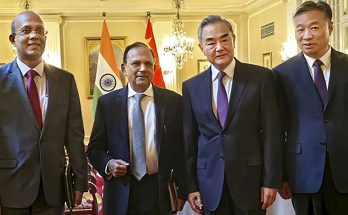 Their soldiers may be slugging it out on the icy heights of Ladakh or Arunachal Pradesh. But their border tensions or geopolitical rivalry haven’t prevented India and China from trading with each other. In fact, bilateral trade between the two countries has seen considerable growth in the last two years since the pandemic and the killing of soldiers in Galwan in 2020.
Their soldiers may be slugging it out on the icy heights of Ladakh or Arunachal Pradesh. But their border tensions or geopolitical rivalry haven’t prevented India and China from trading with each other. In fact, bilateral trade between the two countries has seen considerable growth in the last two years since the pandemic and the killing of soldiers in Galwan in 2020.
According to the data from India’s Ministry of Commerce and Industry, India-China trade rose from the pre-pandemic period in FY 2019-20 to $ 81.26 bn and continues to grow. Beijing emerged as India’s largest trading partner in the first half of FY 2020-21. In the same year, bilateral trade still saw an upward trend even after the deadly clash in the Galwan valley and reached $86.39 bn. Following the clash, the Indian government banned 59 Chinese apps, including popular and high revenue- generating apps such as TikTok, Pub-G, WeChat, and many more on the grounds of data security and privacy. Since then, more than 250 apps have been banned. However, the conflict did not seem to have any significant impact on bilateral trade.
Bilateral trade in the previous year reached an all-time high of $115 bn (FY22). India’s export to Beijing increased from 11.93 bn (FY15) to 21.26 bn (FY22). Similarly, the import also increased from 60.43 bn (FY15) to 94.57 bn (FY22). Electronic goods, pharmaceutical and medical products, organic and inorganic chemicals, fertilisers are some of the major goods imported from Beijing.
The resulting trade deficit between the two clearly reflects who is the gainer. Trade deficit reached $51.5 bn during April-October in 2022. In a written reply to Rajya Sabha (upper house of parliament), Commerce and Industry Minister Piyush Goyal said: “The trade deficit with China in 2004-05 was $1.48 billion, which increased to $36.21 billion in 2013-14, an increase of 2,346%. Against this massive increase, the trade deficit with China has since increased by only 100% to $73.31 billion in 2021-22.”
The major increase in exports from China can be attributed to India’s growing demand for intermediate goods such as pharmaceutical ingredients (APIs) and Chinese machinery despite the Indian government’s efforts to reduce reliance on Chinese goods with initiatives such as “Atmanirbhar Bharat” to promote the domestic industry. Although India has done a good job recovering from the pandemic and becoming the fifth largest economy, it still faces formidable problems. The IMF has also lowered the prediction for India’s GDP growth from 7.4 percent to 6.8 percent for 2022-23, indicating the impact of the Ukraine-Russia war on the supply chains, energy and food sector, inflation and the possibility of a global recession. In addition, Beijing’s property sector is also witnessing slow growth, retreating water levels of Yangtze River (affecting hydro power energy sector) and surging Covid cases in the country which are putting strain on the country’s economy.
(Anish Chetri contributed inputs for this article)
Author Profile
- India Writes Network (www.indiawrites.org) is an emerging think tank and a media-publishing company focused on international affairs & the India Story. Centre for Global India Insights is the research arm of India Writes Network. To subscribe to India and the World, write to editor@indiawrites.org. A venture of TGII Media Private Limited, a leading media, publishing and consultancy company, IWN has carved a niche for balanced and exhaustive reporting and analysis of international affairs. Eminent personalities, politicians, diplomats, authors, strategy gurus and news-makers have contributed to India Writes Network, as also “India and the World,” a magazine focused on global affairs.
Latest entries
 India and the WorldJune 26, 2025Operation Sindoor: India Sheds Restraint, Rediscovers Utility of Force
India and the WorldJune 26, 2025Operation Sindoor: India Sheds Restraint, Rediscovers Utility of Force India and the WorldJune 23, 2025BRICS summit in Rio to focus on Global South, local currency trade
India and the WorldJune 23, 2025BRICS summit in Rio to focus on Global South, local currency trade Africa InsightsJune 11, 2025New Opportunities in India-Japan Cooperation in Africa
Africa InsightsJune 11, 2025New Opportunities in India-Japan Cooperation in Africa India and the WorldMay 23, 2025Post-Operation Sindoor, India reminds Turkey, China of concerns and sensitivities
India and the WorldMay 23, 2025Post-Operation Sindoor, India reminds Turkey, China of concerns and sensitivities







